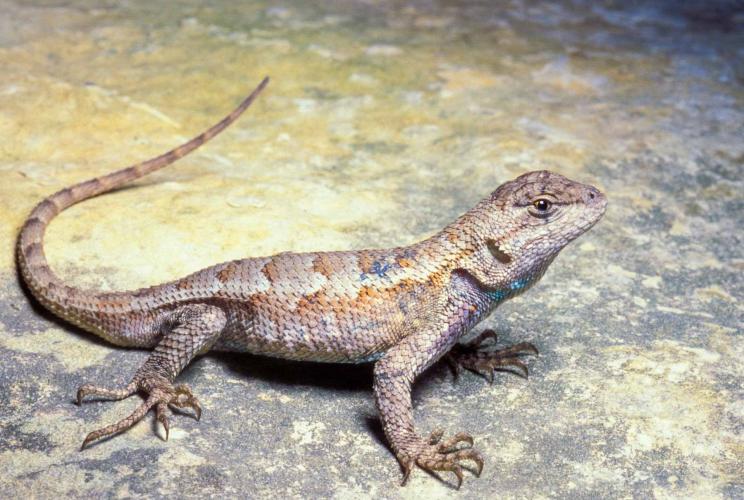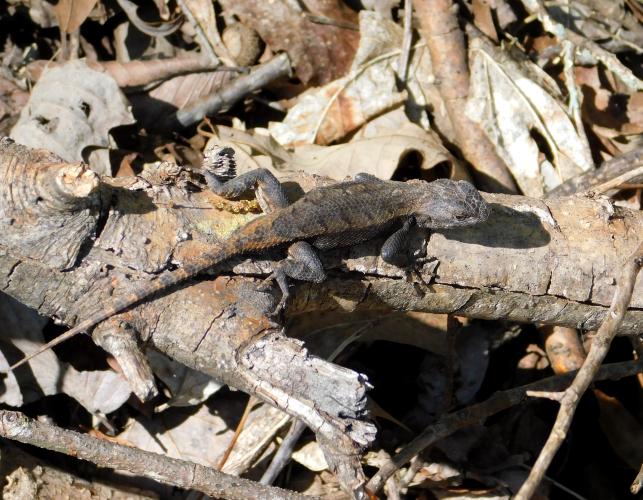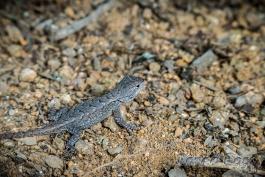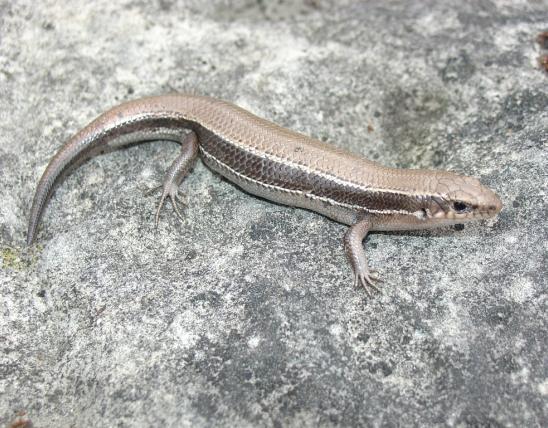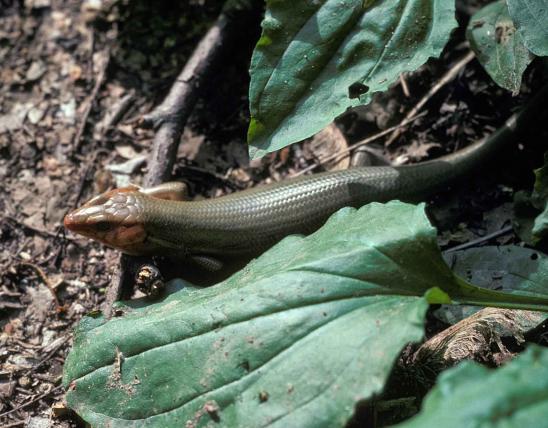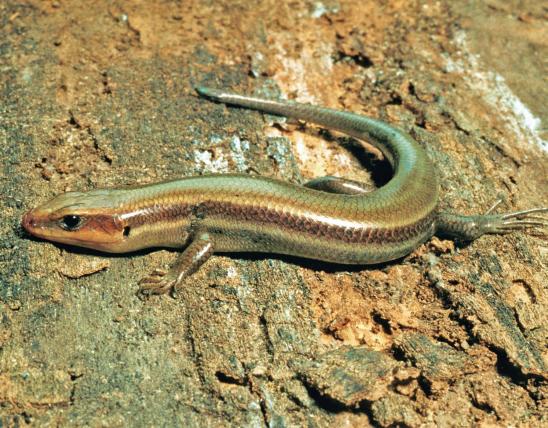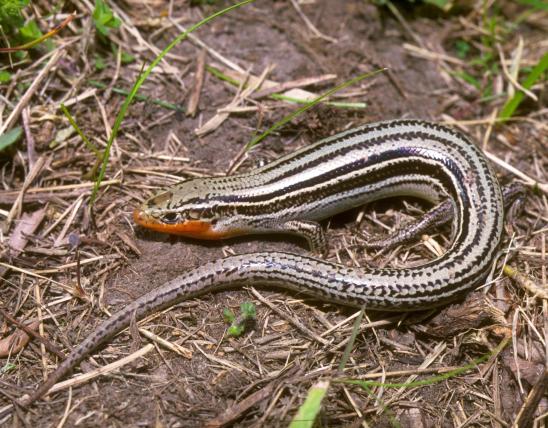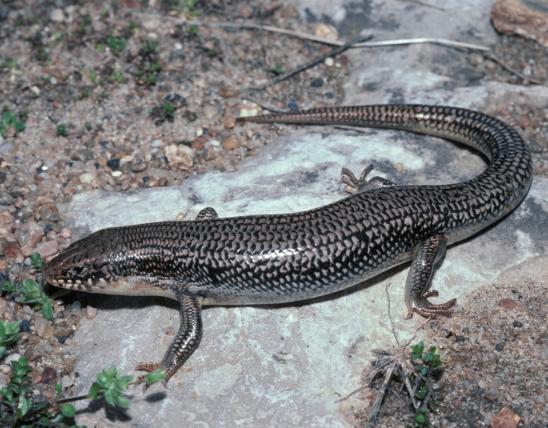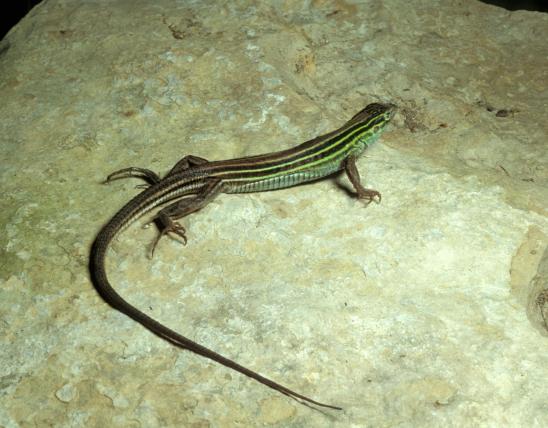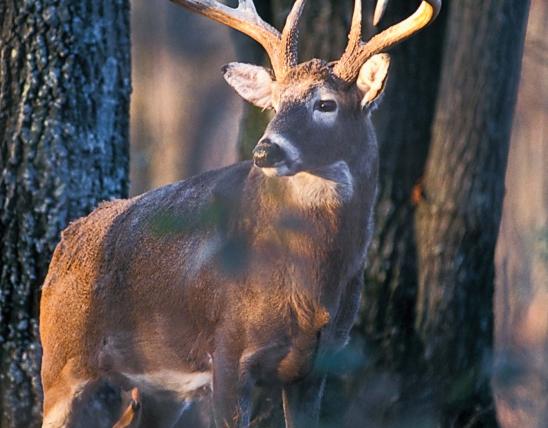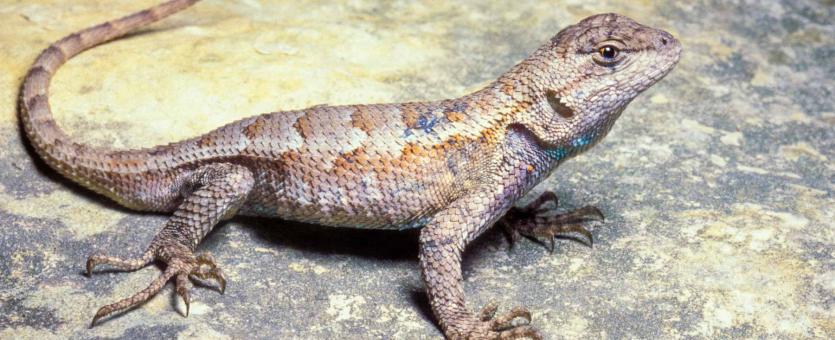
The prairie lizard is a small, gray to brown, rough-scaled lizard. The overall color may be tan, gray, brown, or reddish brown. The color varies by sex. Males are either dark gray or brown on the back, with little or no pattern, and the belly is strongly marked with deep iridescent blue bordered with black. The throat is also blue. Females have distinct wavy lines crossing their backs, with some orange or red at the base of the tail, and the belly is white with faint dark spots. There may be some pale blue along the sides of the belly.
Formerly called the northern fence lizard, this species commonly escapes capture by running up trees.
Similar species: A close relative, the eastern fence lizard (Sceloporus undulatus), is found across the Mississippi River in all border counties in the southern half of Illinois, Kentucky, and Tennessee. This species can be impossible to distinguish from the prairie lizard in Missouri based upon pattern, so DNA testing is needed to positively confirm identification. Although the Mississippi River likely poses a significant barrier to them moving into Missouri, suitable habitat (upland forest) does exist in our state. Thus it is considered a species of possible occurrence in Missouri.
A less closely related species, the prairie earless lizard (Holbrookia maculata perspicua), has been reported a few times from Missouri, several decades ago. However, with the nearest naturally occurring population being about 115 miles away in Kansas, this lizard is not considered a part of the Missouri fauna.
Adult total length: 3½ to 5½ inches.

Prairie lizards occur throughout the southern half of the state and into northeastern Missouri in the Mississippi River Hills.
Habitat and Conservation
In Missouri, prairie lizards live in open woodlands or along the edges of woods and fields and on rocky glades. Tree stumps, downed trees, rock piles, and brush piles are often a part of this lizard’s territory. They are commonly observed around people's homes, where they utilize split rail fences, firewood piles, old lumber piles, decorative railroad ties, and rock walls.
This species is usually active from late March to mid-October. On sunny days it may be seen basking in the sun or foraging for insects between 8 a.m. and 1 p.m. It becomes inactive during the heat of the day, then active again during the late afternoon and evening.
When encountered, this lizard will run along a dead, fallen tree, escape into a rock crevice, or quickly climb a tree — always remaining on the opposite side from the intruder.
Prairie lizards overwinter in underground burrows, rotting tree roots, and stumps, under large rocks, and within rock piles.
Food
This species eats a wide variety of insects but also eats spiders and other invertebrates.
Status
Prairie lizards are relatively common in appropriate habitats. They are often the most common lizard observed by people around homes and buildings.
Taxonomy: This Missouri lizard used to be called the northern fence lizard (Sceloporus undulatus hyacinthinus), a subspecies of eastern fence lizard, but biologists have revised its taxonomy. Now, it’s considered a distinct species, the prairie lizard (S. consobrinus). Older guidebooks, and many people, will still often call this species a “fence lizard.”
Life Cycle
The reproductive season is from March into early August. Courtship and mating begin in the spring soon after the adults emerge from winter retreats and continue into summer.
Egg laying generally occurs from mid-April into late July. A gravid female will locate a suitable nesting site, such as a small patch of loose dirt or an old sawdust pile, and dig a flask-shaped hole. She deposits her eggs within the hole, covers them with dirt, and abandons the nest. Incubation generally lasts 6–8 weeks, and hatchlings begin to emerge from the nest in midsummer through early autumn.
A clutch comprises 4–17 eggs. Females can produce eggs when less than one year old, but only one clutch of eggs is laid the first season. Two-year-old females produce two clutches per season. The first clutch is laid during late May or early June, and the second, if produced, is laid in July.
The eggs hatch in late July and August. The incubation time can vary. When the second clutch of eggs is delayed by being retained in the female, the incubation time is shortened; this allows the young to hatch sooner and have time to grow before the first frost.
Few fence lizards live beyond three years under natural conditions.
Human Connections
As predators, these lizards help decrease populations of many insects that are pests or annoyances to humans.
These familiar, scurrying, camouflaged lizards are a welcome feature of country life.
Human effects on the environment can influence the numbers of this lizard. A long-term study conducted by the Missouri Department of Conservation in the Ozarks showed an increase in number of prairie lizards immediately following tree removal that resulted in opening of the woodlands.
Maintaining and restoring open woodlands, as well as reducing feral cats, will help keep this species common in Missouri.
Ecosystem Connections
Like most lizards, this species preys on insects and other small animals and therefore helps maintain their numbers in a natural balance. This lizard is preyed upon by larger predators, including many mammals and birds. The eggs and young are especially vulnerable to predation.
This is a species of open woodlands, glades, and woodland-grassland borders. Many Missourians don't distinguish between forests and woodlands, calling all wooded areas "the woods." But land managers point out that true forests are completely shaded by a closed canopy of trees, while woodlands are much more open, with dappled sunlight reaching the ground. Woodlands, like prairies and glades, were naturally maintained by periodic fire. Decades of fire suppression led to many of these habitats becoming overgrown with trees. Conservationists, using prescribed fire, are restoring our woodlands, glades, and prairies — and the many different species that live in them.
Missouri has two species — the Texas horned lizard and the prairie lizard — in the family Phrynosomatidae (the spiny and sand lizard family). This family consists of 9 genera with 148 species ranging from southern Canada, most of the United States, and through Central America. Most of these lizards prefer dry, open habitats with rocky outcrops or loose soils. Like the family containing the eastern collared lizard, members of this family have teeth located on the inner surface of the lower jaw and communicate by head bobbing and body pushups. These gestures are used by males to defend their territories and court females. The spiny lizards, in genus Sceloporus, consist of nearly 100 species. Most perch on rocky outcrops, large rotting stumps and logs, fences, and walls. Most males have blue patches on their belly and throat.
